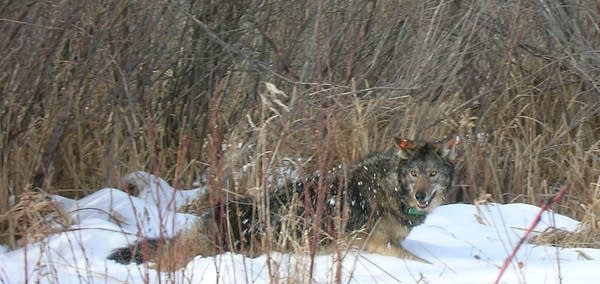Booming wolf population puts wildlife experts on notice

Go Deeper.
Create an account or log in to save stories.
Like this?
Thanks for liking this story! We have added it to a list of your favorite stories.
Wolf populations are generally linked to whitetail deer. There are a lot of deer right now, which means a lot of food for wolves. That in turn means more packs, and more pups living to maturity.
There are now approximately 500 packs, and more than 2,800 wolves across the northern half of the state, according to a Minnesota DNR survey released this week. That's almost 600 more wolves than last year.
"We have a wolf population that is doing really well. By all measures, it's recovered," said Dan Stark, a large carnivore specialist for the DNR.
The wolf survey is done in mid-winter. Researchers fly over a pack's territory and spot them against the snow.
Turn Up Your Support
MPR News helps you turn down the noise and build shared understanding. Turn up your support for this public resource and keep trusted journalism accessible to all.
Stark said the numbers aren't exact, but his best estimates put Minnesota wolf populations at twice the federal minimum for recovery.
That's good for wolves, but there has been some collateral damage.
John Hart is a wildlife specialist for the U.S. Department of Agriculture. It's his job to trap the wolves that take cattle from Minnesota farms. Recently he's been getting more calls than usual.
"Increased deer numbers triggered an increase in wolf numbers, which resulted in, give or take, an increase in wolf depredation on domestic animals," Hart said.
Every year, wolves take cattle from about 100 Minnesota farms and ranches. In response, Hart and his team are hired to trap and euthanize roughly 200 wolves.
Larger litters of pups born this year, mean adult wolves are killing more cattle, Hart said.
"The young of the year aren't really contributing members of the pack, in that they're not really helping hunt and capture food," he said. "But they're growing fast and they need a lot of protein. So the older members of the pack a lot of times are killing domestic animals to keep the entire pack fed."
Since a federal court ruling put an end to Minnesota's wolf hunting season in 2014, Hart and his trappers are the only people allowed to kill wolves. And Stark said they won't be working for much longer.
"They're pretty limited on their resources right now. I mean, currently, their budget runs out Oct. 13," he said. "So, they won't be able to respond to depredation complaints after that date."
Stark says that might be a problem, especially if the coming winter cuts into deer numbers.
"If deer populations go down, there's going to be more wolves and they're looking for things to eat, so we tend to have higher conflicts with livestock," Stark said.


